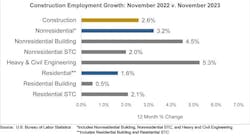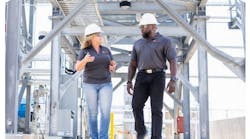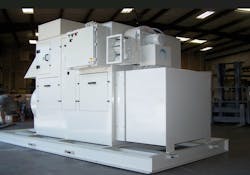Effectively controlling cannabis grow facilities has never been more important. As competition among growers increases -- with demand and profits now plateauing -- optimizing HVAC system design can help producers cut their costs, remain profitable and reap the fruits of their labor.
Grow facilities have different rooms for various stages of the cannabis plant life cycle. These grow spaces require varied sensible and latent setpoints, along with different lighting schedules. Often, this necessitates the installation of independent or dedicated pieces of HVAC equipment to do the job right.
When calculating HVAC loads for grow facilities, moisture is the driving load source. Adding the sensible cooling and latent dehumidification loads together is a common error made when designing environmental control systems for cannabis grow facilities. According to a 2020 article in ASHRAE Journal, engineers rarely consider the fact that the plants often act as their own mini-evaporative coolers.
Plant transpiration is defined as a plant’s physiological loss of water in the form of water vapor, through various processes including evaporation from surfaces of leaves, flowers, and stems. A plant’s transpiration rate will liberate about 70% of its total irrigation water back into the air.
Because plant transpiration (along with evaporation from the watering process) creates an evaporative cooling effect, space sensible heat is converted to latent heat, adding moisture to the air while reducing the overall sensible load and temperature of the room.
Getting the HVAC loads right
Sensible Heat Ratio (SHR) is defined as the percentage of an HVAC unit’s capacity that goes towards sensible cooling at a given set of conditions for a given piece of equipment or space. For a cannabis grow room, it is calculated by dividing the sensible cooling load requirement, in btu’s per hour, by the total (sensible + latent) cooling load requirement.
Most conventional packaged or split system DX or chilled water equipment will perform most effectively when operating at (or above) an 80% SHR. In cases where humidity control needs to drive HVAC system operation, SHRs may be well below 80%. This results in the necessity for “colder” cooling coil temperatures in order to condense more moisture from the air. This can easily tax conventional refrigerant-based cooling systems beyond their ability to properly dehumidify the air, or even remain fully operational.
It is also important to understand that any HVAC unit operating on a demand signal from a space thermostat will provide dehumidification as a byproduct of the run time required to sensibly cool the room. If space sensible loads are quickly satisfied, the run time required to properly dehumidify the air may not be met. Independent space dewpoint temperature monitoring and control, with the ability for the HVAC system to respond accordingly, may be critical to successful grow cycles which will produce the best results.
Decoupling space latent Loads
ASHRAE member Dr. Nadia Sabeh, PhD, PE, president of Dr. Greenhouse, Inc., Sacramento CA, suggests that after determining the required grow room conditions, the next step is to identify equipment that can meet both the sensible and latent loads.
This can be a real challenge because much of the conventional residential and commercial HVAC equipment available is not built to handle both load components effectively.1 For many grow rooms, the SHR can be less than 0.50, which is beyond the capabilities of such equipment.
Dr. Sabeh says she has seen a lot of HVAC equipment undersized for latent loads. Plants generate a lot of moisture in the room and if not controlled properly, the humidity will continue to rise, creating risks for mold growth and condensation on cool surfaces. It is therefore important to select HVAC equipment that can function to meet both temperature and humidity setpoints independently. This helps avoid loss of humidity control, particularly when the lights are off and the SHR has been reduced even further.
The Desiccant difference
To some, desiccant dehumidification may appear to be as foreign or as strange as an extra-terrestrial landing on Earth. But this isn’t the case, so we will here and now dispel the notion that it is anything other than a truly efficient and effective source for indoor grow room environmental control.
First and foremost, solid desiccant dehumidification performs independently of any space sensible cooling requirement, and its operation is not impacted by the resulting SHR of the space. This sets desiccant technology distinctly apart from more conventional dehumidification approaches and provides many advantages well worth considering.
Desiccants are hygroscopic materials having a high affinity for moisture and serve to maintain a state of dryness. They eliminate humidity from the air to create and sustain a moisture-free environment.
Desiccant-based dehumidification transfers water in its vapor phase (molecularly) from the air to the surface of the dry desiccant. This occurs due to the desiccant’s low surface vapor pressure. In essence, desiccants do not condense moisture from the air, nor do they become wet in the way a conventional refrigerant-based cooling coil would.
Because of this, desiccant dehumidification is not impacted by low refrigerant temperatures and cold coil surface temperatures that can frost or freeze evaporators, resulting in ice-blocked coils and nuisance equipment trips or failures.
Another tremendous benefit of a dry desiccant is that it will not promote the growth of mold and other microbial contaminants, like wet cooling coils and drains pan can.
Desiccant dehumidification’s value proposition
In traditional refrigerant-based HVAC air conditioners, a chilled cooling coil reduces the temperature of the air, which in turn condenses water vapor into liquid, thus dehumidifying that air. To deeply dehumidify the air, its temperature must be reduced below the required dewpoint temperature of the space in order to maintain proper relative humidity.
It is commonly known that if deeply dehumidified air is required, it must be over-cooled and then reheated back-up to a warmer temperature more favorable with proper plant management. In addition, this type of dehumidification equipment will fail to provide dewpoint temperatures much below 50°F and will “miss the mark” when lower space SHR’s are a result of diminished sensible space loads.
Solid desiccant dehumidification systems work on the principle of adsorption, and not condensation. This positions desiccants with an ability to convert the latent heat removed from the air into sensible heat, liberated to the airstream as a natural byproduct of the moisture removal process. This both warms and deeply dehumidifies the supply air and provides this energy as a free source of recovered heat. This makes desiccant dehumidification not only very efficient, but also allows it to function independently of space sensible cooling loads, those which are required by DX or chilled water systems in order to cool effectively and remain running.
In its Applications Engineering Manual chapter entitled “Dehumidification in HVAC Systems” (December 2002), Trane, a global manufacturer of DX and chilled water HVAC equipment, suggests that when space loads or process requirements dictate that stringent dew points be provided and maintained, moisture adsorption is preferred for dehumidification and desiccants may be the only viable solution.
Solid desiccant dehumidification technology can outperform all others, particularly when grow operators are looking to overcome some of the shortcomings of conventional refrigerant-based HVAC equipment. Such times include:
- During the “lights-out” mode when space-sensible loads are drastically reduced, and conventional DX or chilled water systems struggle to remain functional;
- When the facility is influenced by high dehumidification loads and conventional DX or chilled water systems fail to provide the necessary dewpoint temperatures;
- When DX or chilled water coils frost-or-freeze trying to achieve the colder temps, leaving air conditions required to remove enough moisture from the air;
- In grow spaces where the SHR falls below 0.80 due to high plant transpiration rates;
- In grow facilities where energy-efficient LED lighting has been installed, lowering space-sensible loads, and reducing the run time of DX or chilled water units;
- In cold weather climates, or conditions where the addition of space heat may be necessary while also providing dehumidification. In this case, the latent heat of adsorption (added to the supply air) is used as recovered heat energy;
- In grow room operations where space dewpoint temperatures below 50°F may be necessary to ensure proper plant growth and outcome.
Conclusion
Solid desiccant dehumidification performs independently of any space sensible cooling requirement, and its operation is not impacted by the resulting SHR of the space. Solid desiccant dehumidification is both simple and thermodynamically eloquent, making it one of the most cost-effective, efficient, and sustainable options a cannabis grow owner or operator could choose.
Desiccant-based systems are utilized in critical environments where indoor relative humidity must be maintained below 45%, and in fact, can perform to more stringent requirements of less than 1% RH, if necessary.
About the Author
David Schurk is Director of Applied Engineering Markets for Innovative Air Technologies in Covington, GA. He has over 40 years of experience in the design and analysis of heating, ventilating, and air-conditioning systems for a variety of market sectors, with a special focus on healthcare and aerospace environmental control and air quality. He can be reached at [email protected].
References
1ASHRAE Journal, Load Calculations for Cannabis Grow Facilities, April 2020.












